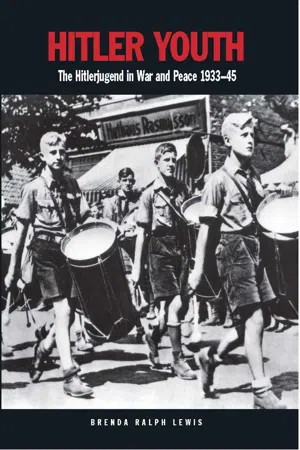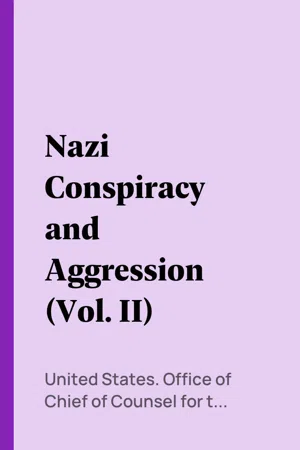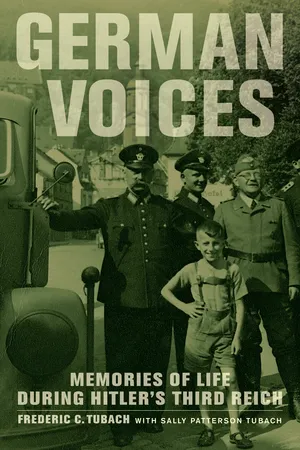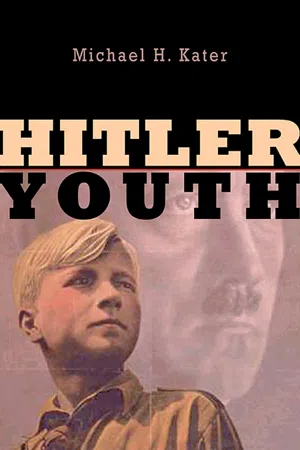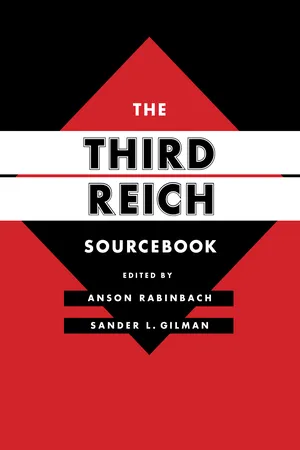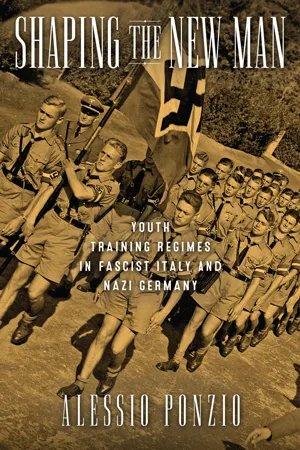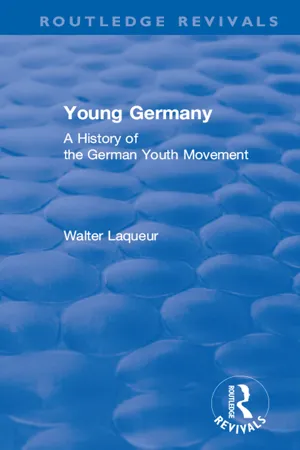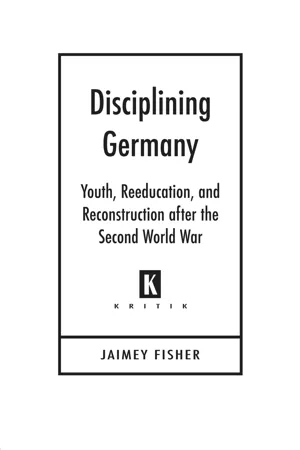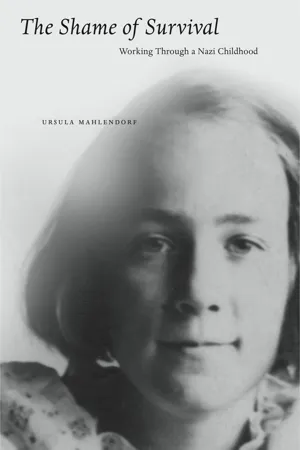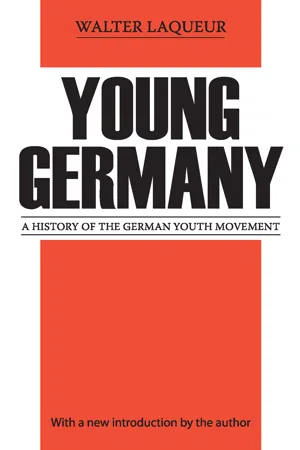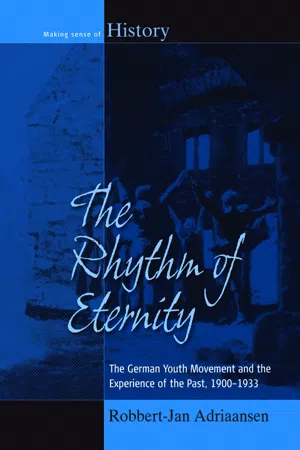History
Hitler Youth
The Hitler Youth was a Nazi youth organization in Germany, established to indoctrinate young people with Nazi ideology and prepare them for military service. It promoted loyalty to Adolf Hitler and the Nazi regime, emphasizing militarism, nationalism, and anti-Semitism. The organization played a significant role in shaping the beliefs and actions of German youth during the Nazi era.
Written by Perlego with AI-assistance
Related key terms
1 of 5
12 Key excerpts on "Hitler Youth"
- eBook - ePub
Hitler Youth
The Hitlerjugend in War and Peace 1933–45
- Brenda Ralph Lewis(Author)
- 2019(Publication Date)
- Amber Books Ltd(Publisher)
In 1934, which he termed ‘The Year of Training’, von Schirach expressed the principles by which unpromising material could be turned into reliable leaders in such a short time. ‘Whoever marches in the Hitler Youth is not a number among millions, but the soldier of an idea,’ he said. ‘The individual member’s value to the whole is determined by the degree to which he is permeated by the idea. The best Hitler Youth, irrespective of rank or office, is he who completely surrenders himself to the National Socialist world view’.TrainingA Hitler Youth was not intended merely as the ‘soldier of an idea’. He was always destined to fight real, hot war on behalf of the Third Reich. The emphasis on arduous physical activity, comradeship and blind devotion to the Führer was intended to harden young men for this purpose. However, as long as peace lasted, the battle to restore the name and reputation of Germany had to be fought in other ways. The Hitler Youth was set to learning trades, working on farms or in private homes, planting trees and flowers to beautify the parks, or rebuilding roads, singing in youth choirs and taking part in music festivals. Some of the boys concentrated on bettering the lives of rural children, who were relatively deprived in the 1930s compared to their town counterparts. For them, the Hitler Youth provided medical and dental care, hygiene facilities such as showers, and exercise programmes to build up their health and physique.Members of the marine Hitler Youth flank a Nazi swastika at the 8th Nazi Party Rally, 8–14 September 1936. From the podium, von Schirach addresses the crowd.The Hitler Youth were required to show a great deal more empathy with the countryside than the occasional rural excursion for hiking or sports or giving help to the disadvantaged. One of the most potent Nazi slogans, ‘Blut und Boden’ (‘Blood and Soil’), was a banner under which the Hitler Youth were supposed to lead a move away from the towns, with their artificial temptations, back to the rural life where the ‘noble peasant’ worked the soil in tune with nature. There, untainted by the metropolitan mixture of the towns where Jews congregated, the peasants preserved the racially pure ethos of Aryan superiority. - eBook - ePub
- United States. Office of Chief of Counsel for the Prosecution of Axis Criminality(Author)
- 2017(Publication Date)
- Perlego(Publisher)
Schirach thus subscribed to the “racial-political task” of the NSDAP and extended his jurisdiction even beyond the border of the German Reich. His encouragement and approval of anti-Jewish terror by youth is discussed below.(6) Through the Hitler Youth, Schirach assisted the Nazi conspirators in developing leaders and members of the NSDAP and its affiliated organizations, including the SA and the SS. Sometime before the launching of aggressive wars, the Hitler Youth had become the principal source of zealous members for the NSDAP and its affiliated organizations. Orders of the Party Chancellery concerned with “successor problems” of the Party emphasize constant attention to Hitler Youth members as future Nazi leaders, thus attempting the perpetuation of the Nazi regime and Nazi ideology for the immediate future and even into future generations. Only Hitler Youth members who distinguished themselves were to be admitted to the Party. Nazi leaders were instructed to use “properly qualified full-time Hitler Youth leaders * * * for the continuation of their political work in the Party service,” so that a necessary succession of full-time leaders in the Leader Corps (Fuehrerkorps ) of the Party would be secured. (3348-PS )The Party manual also discusses the Hitler Youth as a recruitment agency for future Nazi leaders and members of affiliated organizations of the NSDAP:“To secure for the Party valuable and trained recruits for leadership, suitable Hitler Jugend boys of over 17 can be assigned for education and training to leaders from local unit leaders on upwards.”* * * * * *“Besides the above-mentioned conditions for selections in general, a process of elimination results from the fact that from youth on the German is cared for, guided, and educated by the Party. First they are assembled in the Young Folk [Jungvolk ] from which the young people are transferred into the HJ. The boy of the HJ enters the SA, the SS, the NSKK or the NSFK or participates in the work of the affiliated organizations of the Party. After labor and army service, he returns for service to the Party and its affiliates, respectively.” (2401-PS - eBook - PDF
German Voices
Memories of Life during Hitler's Third Reich
- Frederic C. Tubach(Author)
- 2011(Publication Date)
- University of California Press(Publisher)
One interviewee told me that a common strategy used in his school to avoid a feared examination was to ask a fanatic teacher a question about the Nazi movement. In his enthusiasm to respond, the teacher would forget to administer the exam, instead praising the students for their astute political interests. Whatever effect the Hitler Youth had in shaping the minds of young Germans, I believe it was not as great as one might think by watching all the Jungvolk and Hitler Youth marchers, fifers, and drummers in films about the Third Reich—and despite the fact that youth naturally enjoyed these activities immensely. The leaders of these organizations were, of course, convinced Nazis, but they came from the same social and familial envi-ronments as the rest of us, where their rank mattered less than the social status of their family. Hitler Youth leaders sat next to us in our classes, they sweated through the exams with the 56 / Jungvolk and Hitler Youth rest of us, and we were all aware of their fathers’ professions. In short, the Nazi simplifications and slogans could not destroy the diversity of educational experiences the young received during the twelve years of the Third Reich. It mattered a great deal, for example, whether you attended a Gymnasium that emphasized classical languages (Greek or Latin) or a Realgymnasium that stressed modern languages and the sciences. To be sure, the Nazis disseminated educational guidelines throughout Germany, but they were full of vague concepts that lacked any cultural canon to support them. Terms such as “the sphere of the people’s soul” or “the biology of the innermost essence and laws that determine the fate of a Volk ” were of no use in schools accustomed to a defined curriculum. - eBook - PDF
- Michael H. Kater, Michael H. KATER(Authors)
- 2009(Publication Date)
- Harvard University Press(Publisher)
172 The darkest aspect of this entire exercise, in keeping with the racist-imperialistic aims of the Nazis, was that they purposely planted their youth in surroundings known to be hostile to them. This afforded the HJ ample opportunity to point out the difference between HJ children as heirs of the master race on the one side, and those slaves who had already been vanquished, on the other. This was not without danger to the youngsters, who in Occupied Poland and the Protectorate in par-ticular were always regarded with unmitigated hostility in the streets, Serving in the Hitler Youth 47 to the point where it was dangerous for them to be alone or in small groups without the protection of firearms held at the ready by accom-panying senior Hitler Youths. 173 Children were being taught to hate in the field, as it were; they would have to use this skill later at the extended fronts, to defend their status as members of the German rul-ing caste. Problems of Training, Discipline, and Leadership To liberate itself completely from the conventional school system, the Hitler Youth attempted to create educational institutions of its own. These were the Adolf-Hitler-Schulen (AHS), which Baldur von Schirach, behind Reich Minister Rust’s back, in early 1937 conceived in an alliance with Robert Ley, the leader of the German Labor Front (DAF) and a fellow Party dignitary. Not surprisingly, Rust was furious when he found out. Hitler, however, was on the side of Schirach and the schools that would bear his name. The first of these schools was opened on April 20, 1937, the Führer’s forty-eighth birthday, in Pomeranian Crössinsee, at one of Ley’s own training establishments. The projection was for about fifty such schools, at least one for each Nazi Gau or region, with a projected enrollment of 15,000 altogether. By 1941, however, there were only ten schools, and at the end of 1943, a mere 2,027 pupils attended. - eBook - PDF
- Anson Rabinbach, Sander L. Gilman(Authors)
- 2013(Publication Date)
- University of California Press(Publisher)
The future of the German Volk is dependent on its youth. All of Germany’s youth must therefore be prepared for fulfilling their future obligations. The Reich government has thus enacted the following law, which is hereby promulgated. Article 1 All of the German youth within the territory of the Reich shall be members of the Hitler Youth. FIGURE 10. Hitler Youth waving from the windows of a passing train. Photograph no. 09683, United States Holocaust Memorial Museum Photo Archives, Washington, D.C. 252 Nationalizing German Youth Article 2 All of the German youth shall be subject to education not only through family and school but also to physical, mental, and moral training to serve the Volk and the Volk community in the spirit of National Socialism through the Hitler Youth. Article 3 The task of education of the German youth in the Hitler Youth is assigned to the NSDAP youth leader of the Reich, who thus becomes the youth leader of the German Reich [ Reichs-jugendführer ]. He assumes the rank of a higher Reich authority, seated in Berlin and directly subordinate to the Führer and Reich chancellor. Article 4 All of the administrative ordinances and legislative decrees required for the implementation and amplification of this law shall be issued by the Führer and Reich chancellor. 108 SOPADE Reports on German Youth First published in Deutschland-Berichte der Sozialdemokratischen Partei Deutschlands, 1938 (Sopade) (Frankfurt am Main: Verlag Petra Nettelbeck, 1980), 5:1390. It is easier to influence the opinions and sentiments of youth than it is of adults. This fact has made it easier for the regime to win over the youth in the first few years following the col-lapse. It seems as though the same thing is now making it difficult for the regime to keep the youth in its clutches. - eBook - ePub
Conscience In Revolt
Sixty-four Stories Of Resistance In Germany, 1933-45
- Annedore Leber(Author)
- 2021(Publication Date)
- Routledge(Publisher)
1 YOUTH DOI: 10.4324/9780429039027-1 G ERMAN YOUTH, the men and women who grew up after the 1914–1918 war, provided much of the enthusiasm and support which brought Hitler to power. Many of them first became politically conscious in the days of the Weimar Republic. This was a period when good intentions and great efforts at reconstruction, often unappreciated, failed to bring about economic stability and failed also to give young people a purpose in life or a loyalty to democratic society. Strong parties of both Right and Left attacked the foundations of the state. During the economic crisis of 1929–30 subversive activities increased alarmingly and inflation was let loose, working men brought home their wages in suitcases and university students queued up for the dole with millions of unemployed. The ground was well prepared for unscrupulous adventurers; and when the adventurers came, under the banner of a corrupted nationalism, it was above all the young who followed them into the darkest period of German history. These same men and women, and others who grew up later, also had to bear a very heavy share of the misery meted out by National Socialism. They had to kill for it and die for it and at the end even children, boys of 15 or 16, were put into uniform and sent out to stand between the Führer and his henchmen and the encircling armies, to delay by a few weeks or days or hours the inevitable retribution. But the young had to suffer far more than this: they grew up in an atmosphere of authority, fear, distortion, propaganda and hysteria; they were fed with false history and false ideology, and confused by callous invocation of freedom, patriotism and social justice; they were taught to despise individuality and to glory in the corporate bleating of the totalitarian state - eBook - PDF
Shaping the New Man
Youth Training Regimes in Fascist Italy and Nazi Germany
- Alessio Ponzio(Author)
- 2015(Publication Date)
- University of Wisconsin Press(Publisher)
The Führerschulung (leaders’ training) that might have had a great practical value in improving the functioning of the Hitler Youth was carried out sporadi- cally. Prior to the seizure of power, it is incorrect to speak of political indoctri- nation because there was not the organizational machinery to effect it. 4 After the Seizure of Power At the end of 1933, when many youth finally joined the Hitler Youth, the short- age of leaders became more apparent. Between 1933 and 1934 there were in fact thousands of posts to be filled in provincial and central branches. The Hitler Youth urgently needed men and women able to lead and administer large and small units. But such a large number of people could only be trained over time. This Führermangel (lack of leaders) would remain an open wound afflicting the Hitlerjugend for the duration of the regime. 5 To cope with the Führermangel, von Schirach decided to deploy as HJ-Führer individuals who had functioned as leaders in organizations of the pre-Nazi Jugendbewegung. 6 The decision was made after considering several factors. It was only after 1933 that the Hitler Youth effectively enrolled children younger than fourteen years of age. As a consequence, the Nazis became aware of the diffi- culties they faced training younger recruits and decided to rely on former leaders of the Bündische Jugend—the agency collecting under its aegis several associa- tions, such as Scouts and Wandervögel groups, that had been disbanded at the end of 1933. These individuals who had much experience in leading children of ten, eleven, and twelve years of age could teach the Nazis how to manage units 102 The Training of the Hitler Youth Leadership formed by very young members. Moreover, the Nazis believed that they could take advantage of the camaraderie existing within the various groups that comprised the Jugendbewegung, absorbing them into their own movement. - eBook - ePub
Routledge Revivals: Young Germany (1962)
A History of the German Youth Movement
- Walter Laqueur(Author)
- 2018(Publication Date)
- Taylor & Francis(Publisher)
PART FIVEPassage contains an image
IN HITLER’S SHADOW INineteenN ATIONAL Socialism came to power as the party of youth. Its cult of youth may have been less pronounced than that of Italian Facism, whose very hymn was called ‘Giovinezza’; but Hitler lost few opportunities of declaring that his movement was inter alia a revolt of the coming generation against all that was senile and rotten with decay. Yet for all their claims to represent youth, the National Socialists never succeeded in establishing a strong youth movement of their own before 1933. All through the twenties the Hitler Youth remained a negligible force, and in 1933, when it became part of the State apparatus, it lost whatever spontaneity or independence it may ever have had.The establishment of a separate youth group dates back to February 1922, when Hitler demanded this in a circular letter to his Party and in a manifesto published soon afterwards in its newspaper.1 The head of this initial group was a man named Lenk, who soon faded out of the picture—perhaps because he was charged with embezzlement. An interregnum followed, in which the Schill Youth, a right-wing extremist Bund, became for a time the official youth section of the party. Kurt Gruber, who was appointed to succeed Lenk, even announced in a letter to Rossbach, the former Free Corps leader, that he wanted to unite his own young Hitlerite groups in Saxony with the ‘Schill Youth;’1 apparently the National Socialists did not feel confident of an independent success in this field. Nor did the Hitler Youth make much headway under Gruber. As late as 1929, Baldur von Schirach, who had been very successful as a students’ leader and was later to become Gruber’s successor, told Rossbach that ‘the Hitler Youth is badly led and its discipline is indifferent.’2 To the leader of the Geusen, another extreme right-wing Bund, Schirach wrote that he was the friend of both the official party youth organization and the Geusen and that ‘the youth movement and the Hitler Youth cannot be divided.’3 - eBook - ePub
Disciplining Germany
Youth, Reeducation, and Reconstruction After the Second World War
- Jaimey Fisher(Author)
- 2007(Publication Date)
- Wayne State University Press(Publisher)
Hitler Youth , which, although it effectively covers the institutional history of the Hitler Youth and incorporates more recent scholarship on the experiences of young people, still focuses on the youth group itself rather than its place either in the party hierarchy, the wider social context, or the cultural imaginary of Nazism in general. While I will give some background details on the institutions housing youth in the Nazi and postwar periods, I am primarily concerned with how discussion and debates about the “German youth” and the “younger generation” became, within (adult) culture in general, a key site on which to displace questions of the past and guilt for its crimes. Although I cannot hope to offer a full accounting of how young people facilitated the rise of the Nazi Party—a topic worthy of a much fuller study than I can offer herein—I shall demonstrate how at least certain sectors of Nazi culture imagined the Nazi revolution as a youth revolution. This imagined role of the young in remaking Germany provides important background for the rest of my study because it would prove remarkably influential in early postwar narrations of Nazism and, subsequently, in early postwar attempts to come to terms with the Nazi past.YOUTH , HITLER -JUGEND, AND THE NAZI MOVEMENTWhile Schirach suggests that he built up the Hitler-Jugend, it is closer to the truth to observe that he did not lay the necessary groundwork for the movement. This disjuncture reflects the complex relation between the youth group and the Nazi Party, which clouds the common assumption that the young were indispensable in the ascent of National Socialism. There is, in fact, significant scholarly disagreement on the importance of youth for the Nazi movement and for the regime. While most scholars seem to assume that youth played a pivotal role in the movement, scholars like Joachim Radku and Bernd Hüppauf have suggested that Nazism did not rest on the backs of the young as much as widely assumed.4 In fact, the early organizational and foundational institutional work was done not by members of Hitler’s inner circle like Schirach but by others, and the Hitler-Jugend had roots in the independent youth movement of the 1920s and even in the pre–World War I period, rather than in the Nazi Party. As was true of much of German society during these years, the changing character of the Hitler-Jugend—the name it was given only in 1926—reflected the increasing politicization of society during the Weimar period, during which the group was as much youth organization as party branch.5 - eBook - PDF
The Shame of Survival
Working Through a Nazi Childhood
- Ursula Mahlendorf(Author)
- 2009(Publication Date)
- Penn State University Press(Publisher)
I do know, though, You Are the Future Leadership of the Hitler Youth 113 that almost all local nonpaid hj leaders were middle or high school students. They had Wednesday afternoons free till age sixteen or eighteen, while pri- mary school students went to work at age fourteen and were treated as adults. They had neither the time nor, many, the inclination to lead a group of young- sters. The very contingencies of schooling and working made it inevitable that local Nazi youth leadership, once hj included all children from ten to four- teen, became middle class regardless of the ideology of social equality within the Volksgemeinschaft. Books on Hitler Youth speak only about the training institutions set up for the higher echelon of leaders who aimed for careers working with youth. Soon after his appointment as the national youth leader in 1933, Baldur von Schirach created a number of leadership training institutions. The first, located in Potsdam, close to Berlin, was to serve as a model for all the others. Schirach claimed that twenty-one had been opened by 1934. By 1938 a full training pro- gram had been developed, modeling what the Nazis expected of their leaders in general and the hj leadership in particular. A member of the hj could be asked to apply for leadership training if he or she could bring proof of being of pure German, Aryan descent and in excellent physical health without any trace of hereditary illness. The applicant had to display the proper National Socialist attitude, have served successfully as a local hj leader, be physically and mentally fit, and have completed occu- pational/professional training or be matriculated at a university. The suitabil- ity of the applicant was to be tested in a preliminary training course; after successfully completing the course, the candidate had to finish the required labor service as well as military service. - eBook - ePub
Young Germany
History of the German Youth Movement
- Walter Laqueur(Author)
- 2017(Publication Date)
- Routledge(Publisher)
Rolandbriefe in the Rhineland. Of the youth organizations grudgingly permitted a semi-legal existence, the Catholic groups were the only ones in which something of the spirit of the youth movement survived; they were kept under close surveillance and their activities restricted by special administrative measures. Certain Protestant groups also continued to be active, and took part in Boy Scout camps outside Germany.But the ‘Hitler Youth Law,’ which was promulgated on 1 December, 1936, put an end to the semi-legal status of confessional groups. Every boy and girl now had to belong to the State youth organization. One noteworthy consequence was that, whereas National Socialism had in previous years attacked the Bünde for their elitist practices, the Hitler Youth now found itself forced to assume a still more invidiously élitist structure. Its rank-and-file members, enrolled by legal obligation, were sharply differentiated from the ‘hard core’ of earlier adherents, the so-called Stamm Hitler Youth, who provided leaders for the mass organization.III
The Bünde had ceased to exist; but the Hitler Youth was imperfectly satisfied by its triumph. Elimination of its rivals by force of law was not enough; they must also be discredited ideologically, condemned before the bar of history so that their evil spirit could be exorcised for ever. Baldur von Schirach began his work on the youth movement with the words: ‘What was previously called the German youth movement is dead.’1 That was indisputable in 1934, but what was to be its place in history? Had it been a help or a hindrance to the resurrection of Germany under Adolf Hitler? His answer was that some of the ideas of the youth movement and a part of its way of life had influenced the Hitler Youth and been taken overby them2 —for instance, the idea that youth should be led by youth only, the rejection of the concepts of bourgeois society, the exaltation of comradeship, of defence of the homeland and the Volkstum. But beyond this their ideas were nebulous, their aims confused, and the best thing about the Hohe Meissner was not the speeches but the boys and girls listening to them. In the view of von Schirach and other National Socialist publicists, the youth movement had done good work up to the First World War, but had become a mainly destructive influence after 1918; the Bünde had all the weaknesses of the earlier Wandervogel without its merits. Most of their members had failed to recognize that a saviour had arisen in the person of Adolf Hitler; they had been weak and undecided; even those who accepted the basic truths of National Socialism had refused to draw the practical conclusions.1 Some of those aristocratic individualists had even professed sympathy with the ‘spiritual aims’ of National Socialism, and then said they did not think Hitler was the right man!2 - eBook - PDF
The Rhythm of Eternity
The German Youth Movement and the Experience of the Past, 1900-1933
- Robbert-Jan Adriaansen(Author)
- 2015(Publication Date)
- Berghahn Books(Publisher)
Hence, I limit my study to the Wilhelmine era (1871–1918) and the Weimar period (1918–1933) of German history. Examining what was left of the youth movement in Nazi Germany would also require an in-depth analysis of the specific historical culture of Nazi Germany, which is far beyond the scope of this study, because the ideological historical culture of Nazi Germany strove towards a discon-tinuation with earlier Wilhelmine and Weimarian historical cultures on almost all fronts. 9 In this chapter I will present the guiding question of my research. Three theoretical notions will provide an interpretive framework in order to explain the significance of my question: experience, representation and presence. After presenting my research question, I will discuss two important historiographical debates to contextualize my research, namely the German youth movement and the historiographical discussion on the ‘Conservative Revolution’. I will end the chapter with an explanation about sources and methods, and give the outline of the study. Aims and Research Question This study focuses on the development of various conceptions of history in the German youth movement in the first decades of the twentieth century.The 4 The Rhythm of Eternity youth movement was an educative environment in which young people grew up together, shared the same ‘space of experience’, and phrased ideas on past, present and future on the basis of these shared experiences. 10 My aim, however, is not just to write a history of the youth movement’s historical development. The case of the youth movement opens up the larger philosophical ques-tion on the possibilities and impossibilities of thinking ‘beyond’ modernity by revising the premises of modern historical thought.
Index pages curate the most relevant extracts from our library of academic textbooks. They’ve been created using an in-house natural language model (NLM), each adding context and meaning to key research topics.
